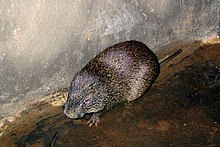The greater cane rat (Thryonomys swinderianus), also known as the grasscutter (inGhana, Nigeria and other regions of West Africa), is one of two species of cane rats, a small family of African hystricognath rodents.[2] It lives by reed-beds and riverbanks in Sub-Saharan Africa.
| Greater cane rat | |
|---|---|

| |
| Scientific classification | |
| Domain: | Eukaryota |
| Kingdom: | Animalia |
| Phylum: | Chordata |
| Class: | Mammalia |
| Order: | Rodentia |
| Family: | Thryonomyidae |
| Genus: | Thryonomys |
| Species: |
T. swinderianus
|
| Binomial name | |
| Thryonomys swinderianus (Temminck, 1827) | |

| |
Greater cane rats can measure in head-and-body length from 43 to 60 cm (17 to 24 in) with the tail measuring 16 to 19.5 cm (6.3 to 7.7 in). Typical weight is 3.2 to 5.2 kg (7.1 to 11.5 lb), in males averaging some 4.5 kg (9.9 lb), and females at 3.4 to 3.8 kg (7.5 to 8.4 lb). In some cases, greater cane rats can weigh to approximately 7 to 9 kg (15 to 20 lb). They are considered one of the largest rodents in Africa, behind only the Hystrix porcupines.[3][4][5][page needed] It has rounded ears, a short nose, and coarse bristly hair. Its forefeet are smaller than its hind feet, each with three toes.
Cane rats live in small groups led by a single male. They are nocturnal and make nests from grasses or burrow underground. Individuals of the species may live in excess of four years. If frightened, they grunt and run towards water.
As humans expanded into the cane rat's native habitats, the cane rats likewise expanded from their native reeds into the plantations, particularly the sugar cane plantations from which they derive their name. Their tendency to adopt plantations as habitat, where they feed on agricultural crops such as maize, wheat, sugar-cane and cassava, often earns them the label of agricultural pest. However, the peoples of the region also utilize the cane rat as a food source (asbushmeat), considering the meat a delicacy. Consequently, these rats are beginning to be raised in cages for sale.[6]